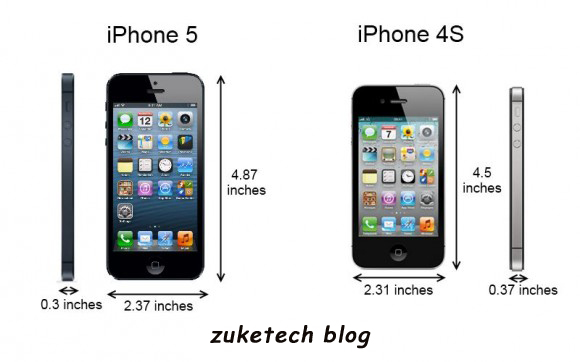Apple took to the stage earlier today to announce the iPhone 5, and there will be plenty of people around the world ready to get their hands on a new smartphone on September 21. Only, many of them will be just as happy to get their hands on the now cheaper iPhone 4S. With the price drop, it may not be entirely obvious which device is the best bang for your buck. Obviously those who want the latest and greatest are happy to spend the extra money, but when you compare the two devices side by side, how do they compare?
Dimensions
The iPhone line of devices has an iconic style and design all its own. The iPhone 4S is the second in a refreshed design line, which took the 3.5″ smartphone to a box like shape with glass on both sides. The .37″ thickness feels great in the palm of any hand, while only managing to be 2.31″ wide. The iPhone 5′s .3″ thick frame is noticeably thinner despite being more powerful and containing more hardware. The difference in width is negligible, so they are going to feel quite similar in the hand.
Display
Since the original iPhone, this line of smartphone has had the same screen size. When the iPhone 4 was announced, we saw a significant increase in screen quality with the Retina display, but still the same size screen. The iPhone 4S has a 3.5″ IPS display that can produce a 960 x 640 resolution image. At 330 ppi, this 4:3 display is still one of the best displays available when compared to other devices. The iPhone 5′s new larger screen breaks the iPhone mold a bit, but also ads quite a bit, too. The 4″ screen offers up a 1136 x 640 resolution display. On top of being a larger screen, the aspect ratio on this 326 ppi screen has also changed to 16:9. It has much better color saturation, and touch is integrated directly into the display making it more accurate.
Wireless
Apple has lagged behind the rest of the smartphone world a bit when it comes to the next generation of wireless connectivity. The iPhone 4S is a 3G device, capable of connecting to HSPA+ on AT&T and CDMA on Sprint and Verizon networks. While these networks are more than capable of delivering normal content, nearly every carrier is fast at work pushing the new LTE network across the world. On top of the 3G radio in the 4S, the iPhone 5′s LTE radio will be capable of taking advantage of the significant increase in speeds offered by many global carriers.
Processor
Every version of the iPhone has had a special processor that has been made under Apple’s supervision by other companies. The iPhone 4S features a dual-core A5 processor clocked to 800MHz. While many have seen this processor as being underclocked, the iPhone 4S is almost never found to be sluggish or lagging. The processor in the iPhone 5 is Apple’s new A6 chip, which boasts an increase in performance as well a smaller overall processor. Apple says both the CPU and GPU offers a 2x performance bump over the A5 chip, so iOS should fly along.
RAM
In a world where you can’t find an Android device out there with less than 1GB of RAM, the 512mb of RAM in the iPhone 4S may seem insufficient. When you hold a 4S in your hand and use it, however, you find that 512mb is more than enough to drive this smartphone. Given the new processor in the iPhone 5, however, it only makes sense that Apple’s latest smartphone would be packing 1GB of RAM to keep up with the much faster processor. 1GB isn’t officially listed on Apple’s iPhone 5 spec sheet, but we’d be very surprised if this wasn’t the amount being used.
Camera
The iPhone 4S camera is the standard to which most other smartphone cameras are compared to. The 8MP camera on the iPhone 4S is capable of taking terrific photos, as well as recording 1080p videos. The software that accompanies the iPhone camera allows users to take photos that are often mistaken for professional shots. The iPhone 5 camera is still 8MP (3264 x 2448), but the technology inside is significantly improved. The backlit sensor and five element lens on the iPhone 5 camera, being called iSight, will allow photos to be taken in low light situations with better noise reduction. There’s also a Panorama view capable of capturing 28MP images.
Battery
There’s no way to access the battery on an iPhone, so it is important that the device be able to get you through the whole day. The iPhone 4S has been able to deliver an all day experience to many users with its 1,432mAh battery, which according to Apple gets you about six hours of continuous heavy use. Apple’s latest iPhone is reportedly packing a 1440mAh battery, which promises to deliver eight hours of continuous heavy use. Especially given the LTE radio inside the iPhone 5, that is an impressive figure.
Storage
There’s no removable storage offered with the iPhone line, so whatever model you get for storage you are stuck with, unless you get something like a WiDrive. The iPhone 4S is available in 16GB, 32GB, and 64GB, with a price scale to match. The iPhone 5 mirrors this exactly on both storage levels and price ($199, $299, and $399 respectively).
Weight
Your phone is something that you have in your pocket all day, every day. While it seems silly to pay attention to something like weight when it comes to something so small, the difference half an ounce makes is surprising. The iPhone 4S weighs in at 4.9oz, which is lighter than many of the other phones that are out there today. Compared to the iPhone 5, which weighs in at 3.95 oz, the handset will probably only feel lighter if you happen to be holding both of them.





























